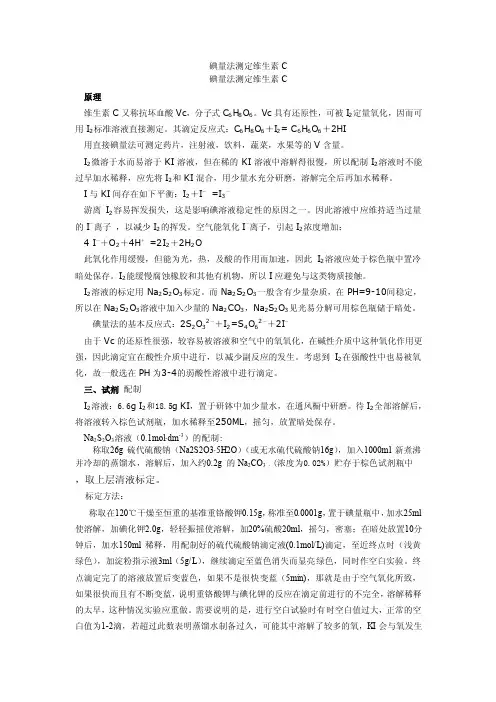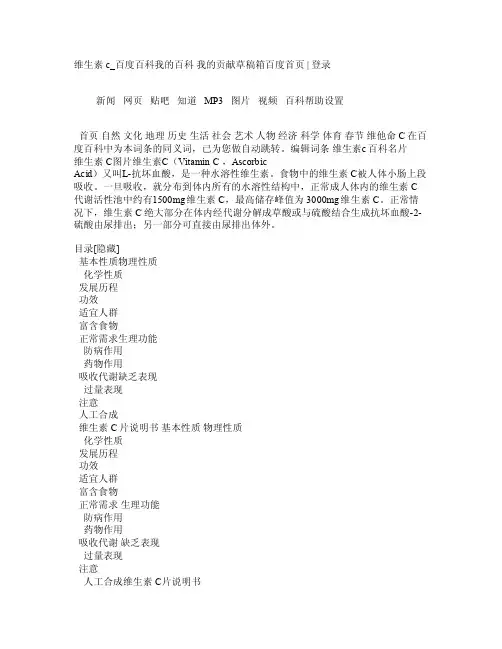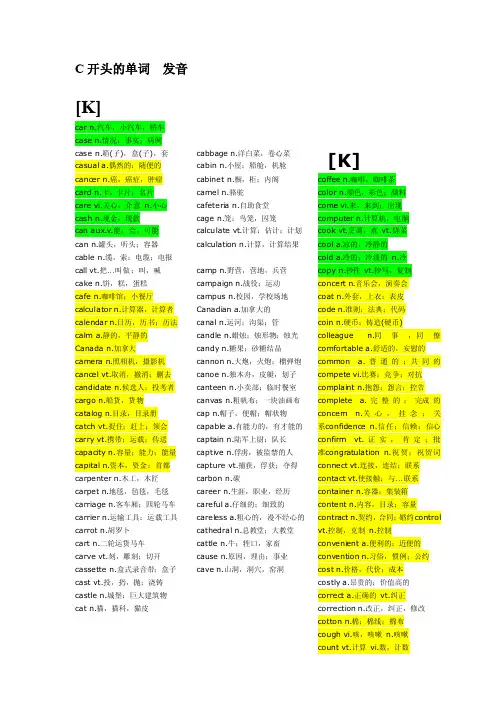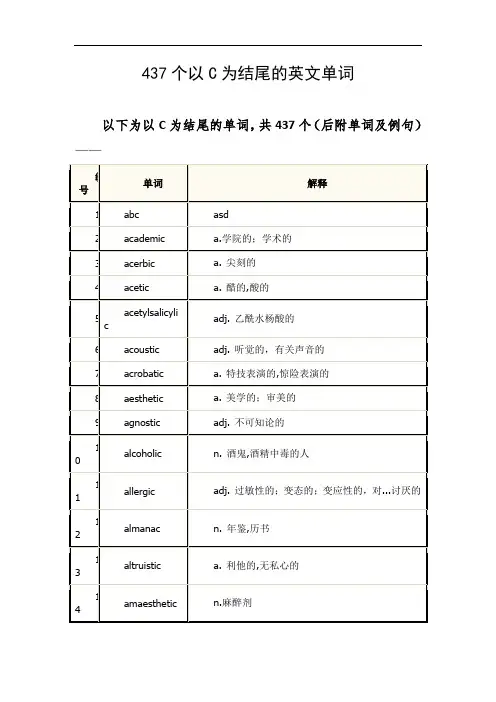C#中如何调用按键精灵插件
碘量法测定维生素C

碘量法测定维生素C碘量法测定维生素C原理维生素C又称抗坏血酸Vc,分子式C6H8O6。
Vc具有还原性,可被I2定量氧化,因而可用I2标准溶液直接测定。
其滴定反应式:C6H8O6+I2= C6H6O6+2HI用直接碘量法可测定药片,注射液,饮料,蔬菜,水果等的V含量。
I2微溶于水而易溶于KI溶液,但在稀的KI溶液中溶解得很慢,所以配制I2溶液时不能过早加水稀释,应先将I2和KI混合,用少量水充分研磨,溶解完全后再加水稀释。
I与KI间存在如下平衡:I2+I-=I3-游离I2容易挥发损失,这是影响碘溶液稳定性的原因之一。
因此溶液中应维持适当过量的I-离子,以减少I2的挥发。
空气能氧化I-离子,引起I2浓度增加:4 I-+O2+4H+=2I2+2H2O此氧化作用缓慢,但能为光,热,及酸的作用而加速,因此I2溶液应处于棕色瓶中置冷暗处保存。
I2能缓慢腐蚀橡胶和其他有机物,所以I应避免与这类物质接触。
I2溶液的标定用Na2S2O3标定。
而Na2S2O3一般含有少量杂质,在PH=9-10间稳定,所以在Na2S2O3溶液中加入少量的Na2CO3,Na2S2O3见光易分解可用棕色瓶储于暗处。
碘量法的基本反应式:2S2O32-+I2=S4O62-+2I-由于Vc的还原性很强,较容易被溶液和空气中的氧氧化,在碱性介质中这种氧化作用更强,因此滴定宜在酸性介质中进行,以减少副反应的发生。
考虑到I2在强酸性中也易被氧化,故一般选在PH为3-4的弱酸性溶液中进行滴定。
三、试剂配制I2溶液:6.6g I2和18.5g KI,置于研钵中加少量水,在通风橱中研磨。
待I2全部溶解后,将溶液转入棕色试剂瓶,加水稀释至250ML,摇匀,放置暗处保存。
Na2S2O3溶液(0.1mol·dm-3)的配制:称取26g硫代硫酸钠(Na2S2O3·5H2O)(或无水硫代硫酸钠16g),加入1000ml新煮沸并冷却的蒸馏水,溶解后,加入约0.2g 的Na2CO3 ,(浓度为0.02%)贮存于棕色试剂瓶中,取上层清液标定。
C开头英文单词

词汇表(C-D ): cabbage n.洋白菜,卷心菜 cabin n.小屋;船舱,机舱 cabinet n.橱,柜;内阁 cable n.缆,索;电缆;电报 cafe n.咖啡馆;小餐厅 cafeteria n.自助食堂 cage n.笼;鸟笼,囚笼 cake n.饼,糕,蛋糕 calculate vt.计算;估计;计划 calculation n.计算,计算结果 calculator n.计算器,计算者 calendar n.日历,历书;历法 call vt.把…叫做;叫,喊 calm a.静的,平静的 camel n.骆驼camera n.照相机,摄影机camp n.野营,营地,兵营campaign n.战役;运动 campus n.校园,学校场地 can aux.v.能,会,可能 can n.罐头,听头;容器 Canada n.加拿大Canadian a.加拿大的 canal n.运河;沟渠;管 cancel vt.取消,撤消;删去cancer n.癌,癌症,肿瘤candidate n.候选人;投考者candle n.蜡烛;烛形物;烛光candy n.糖果;砂糖结晶cannon n.大炮,火炮;榴弹炮canoe n.独木舟,皮艇,划子canteen n.小卖部;临时餐室canvas n.粗帆布;一块油画布cap n.帽子,便帽;帽状物 capable a.有能力的,有才能的capacity n.容量;能力;能量 capital n.资本,资金;首都 captain n.陆军上尉;队长 captive n.俘虏,被监禁的人 capture vt.捕获,俘获;夺得 car n.汽车,小汽车,轿车carbon n.碳 card n.卡,卡片,名片 care vi.关心,介意 n.小心 career n.生涯,职业,经历 careful a.仔细的;细致的 careless a.粗心的,漫不经心的 cargo n.船货,货物 carpenter n.木工,木匠 carpet n.地毯,毡毯,毛毯 carriage n.客车厢;四轮马车carrier n.运输工具;运载工具 carrot n.胡罗卜carry vt.携带;运载;传送 cart n.二轮运货马车 carve vt.刻,雕刻;切开case n.情况;事实;病例case n.箱(子),盒(子),套 cash n.现金,现款cassette n.盒式录音带;盒子 cast vt.投,扔,抛;浇铸castle n.城堡;巨大建筑物casual a.偶然的;随便的cat n.猫,猫科,猫皮 catalog n.目录,目录册catch vt.捉住;赶上;领会 cathedral n.总教堂;大教堂 cattle n.牛;牲口,家畜cause n.原因,理由;事业cave n.山洞,洞穴,窑洞cease vi.&vi.&n.停止,停息 ceiling n.天花板,顶蓬 celebrate vt.庆祝;歌颂,赞美cell n.细胞;小房间 cellar n.地窑,地下室cement n.水泥;胶泥 vt.粘结cent n.分;分币;百 centigrade a.百分度的 centimetre n.公分,厘米 central a.中心的;主要的 centre n.中心;中枢 vt.集中 century n.世纪,百年 ceremony n.典礼,仪式;礼节 certain a.确实的;肯定的 certainly ad.一定,必定;当然 certainty n.必然;肯定 certificate n.证书,证件,执照 chain n.链,链条,项圈chair n.椅子;主席 chairman n.主席;议长,会长chalk n.白垩;粉笔 challenge n.挑战;要求,需要 chamber n.会议室;房间;腔 champion n.冠军,得胜者 chance n.机会,机遇;可能性change n.改变,变化;零钱channel n.海峡;渠道;频道chapter n.章,回,篇 character n.性格;特性;角色characteristic a.特有的 n.特性charge vt.索价;控告 n.费用 charity n.施舍;慈善事业 charming a.迷人的,可爱的chart n.图,图表;海图 chase n.追逐,追赶,追求cheap a.廉价的;劣质的cheat vt.骗取;哄 vi.行骗 check vt.检查;制止 n.检查 cheek n.面颊,脸蛋cheer vt.使振作;欢呼 cheerful a.快乐的,愉快的cheese n.乳酪,干酪 chemical a.化学的 n.化学制品 chemist n.化学家;药剂师chemistry n.化学cheque n.支票 cherry n.樱桃;樱桃树 chess n.棋;国际象棋 chest n.胸腔,胸膛;箱子 chew vt.咀嚼,嚼碎 chicken n.小鸡,小鸟;鸡肉 chief a.主要的;首席的 child n.小孩,儿童;儿子 childhood n.童年,幼年;早期 childish a.孩子的;幼稚的 chill vt.使变冷 n.寒冷 chimney n.烟囱,烟筒;玻璃罩chin n.颏,下巴China n.中国china n.瓷器,瓷料 Chinese a.中国的 n.中国人 chocolate n.巧克力;巧克力糖 choice n.选择,抉择 choke vt.使窒息;塞满 choose vt.选择,挑选;情愿chop vt.砍,劈;切细vi.砍Christian n.基督教徒;信徒 Christmas n.圣诞节 church n.教堂,礼拜堂;教会cigarette n.香烟,纸烟,卷烟cinema n.电影院;电影,影片 circle n.圆,圆周;圈子 circuit n.电路;环行;巡行 circular a.圆的;循环的 circulate vt.使循环 vi.循环circumference n.圆周,周长,圆周线 circumstance n.情况,条件;境遇citizen n.公民;市民,居民city n.城市,都市 civil a.公民的;文职的 civilization n.文明,文化;开化civilize vt.使文明;教育 claim vt.声称,主张;索取 clap vi.拍手 vt.拍,轻拍 clarify vt.澄清,阐明 clasp n.扣子,钩子;别针class n.班,班级;阶级classical a.古典的;经典的 classification n.分类;分级;分类法 classify vt.把…分类 classmate n.同班同学 classroom n.教室,课堂 claw n.爪,脚爪,螯 clay n.粘土,泥土;肉体 clean a.清洁的;纯洁的 clear a.清晰的 vt.清除 clearly ad.明白地,清晰地 clerk n.店员;办事员,职员 clever a.聪明的;机敏的cliff n.悬崖,峭壁 climate n.气候;风土,地带 climb vi.攀登,爬 vt.爬 cloak n.斗篷;覆盖(物) clock n.钟,仪表 close vt.关,闭;结束 closely ad.紧密地,接近地cloth n.布;衣料;桌布 clothe vt.给…穿衣服 clothes n.衣服,服装;被褥 clothing n.衣服,被褥 cloud n.云;云状物;阴影cloudy a.多云的;云一般的club n.俱乐部,夜总会 clue n.线索,暗示,提示 clumsy a.笨拙的;愚笨的coach n.长途公共汽车 coal n.煤,煤块 coarse a.粗的,粗糙的 coast n.海岸,海滨(地区)coat n.外套,上衣;表皮cock n.公鸡;雄禽;旋塞code n.准则;法典;代码coffee n.咖啡,咖啡茶 coil n.(一)卷;线圈 vt.卷coin n.硬币;铸造(硬币)cold a.冷的;冷淡的 n.冷collapse vi.倒坍;崩溃,瓦解 collar n.衣领,项圈colleague n.同事,同僚collect vt.收集 vi.收款 collection n.搜集,收集;收藏品 collective a.集体的;集合性的 college n.学院;大学 collision n.碰撞;冲突 colonel n.陆军上校;中校 colony n.殖民地;侨居地 color n.颜色,彩色;颜料 column n.柱,支柱,圆柱 comb n.梳子 vt.梳理 combination n.结合,联合;化合 combine vt.使结合;兼有 come vi.来,来到;出现comfort n.舒适;安慰 vt.安慰comfortable a.舒适的,安慰的command vt.命令,指挥;控制commander n.司令官,指挥员comment n.评论,意见;注释commerce n.商业,贸易;社交commercial a.商业的;商品化的commission n.委任状;委员会commit vt.犯(错误);干(坏事) committee n.委员会;全体委员 common a.普通的;共同的 commonly ad.普通地,一般地 communicate vi.通讯;传达;传播 communication n.通讯;传达;交通 communism munist 主义 communistmunistparty 员 community n.社区;社会;公社 companion n.同伴;共事者;伴侣 company n.公司,商号;同伴 comparative a.比较的,相对的compare vt.比较,对照;比作comparison n.比较,对照;比似 compass n.罗盘,指南针;圆规 compel vt.强迫,迫使屈服 compete vi.比赛;竞争;对抗 competent a.有能力的;应该做的 competition n.竞争,比赛 compile vt.编辑,编制,搜集 complain vi.抱怨,拆苦;控告 complaint n.抱怨;怨言;控告 complete a.完整的;完成的 completely ad.十分,完全地 complex a.结合的;复杂的 complicate vt.使复杂;使陷入 complicated a.复杂的,难懂的 component n.组成部分;分;组件 compose vt.组成,构成;创作 composition n.构成;作品;写作 compound n.化合物;复合词 comprehension n.理解,理解力;领悟 comprehensive a.广泛的;理解的 compress vt.压紧,压缩 comprise vt.包含,包括;构成 compromise n.妥协,和解compute vt.计算,估计,估算computer n.计算机,电脑comrade n.同志,亲密的同伴conceal vt.把…隐藏起来concentrate vt.集中;聚集;浓缩concentration n.集中;专注;浓缩concept n.概念,观念,设想concern n.关心,挂念;关系concerning prep.关于 concert n.音乐会,演奏会conclude vt.推断出;结束conclusion n.结论,推论;结尾 concrete n.混凝土;具体物 condemn vt.谴责,指责;判刑 condense vt.压缩,使缩短 condition n.状况,状态;环境 conduct n.举止,行为;指导 conductor n.售票员;(乐队)指挥 conference n.会议,讨论会 confess vt.供认,承认;坦白 confidence n.信任;信赖;信心 confident n.确信的,自信的 confine vt.限制;禁闭 confirm vt.证实,肯定;批准conflict n.争论;冲突;斗争confuse vt.使混乱,混淆confusion n.混乱;骚乱;混淆congratulate vt.祝贺,向…道喜congratulation n.祝贺;祝贺词congress n.大会;国会,议会conjunction n.接合,连接;连接词connect vt.连接,连结;联系connection n.连接,联系;连贯性conquer vt.征服,战胜;破除conquest n.攻取,征服;克服 conscience n.良心,道德心 conscious a.意识到的;有意的 consciousness n.意识,觉悟;知觉 consent n.同意,赞成vi.同意 consequence n.结果,后果 consequently ad.因此,因而,所以 conservation n.保存,保护;守恒 conservative a.保守的 n.保守的人 consider vt.认为;考虑;关心 considerable a.相当大的;重要的 considerate a.考虑周到的;体谅的 consideration n.考虑,思考;体贴 consist vi.由…组成;在于 consistent a.坚持的,一贯的 constant a.经常的;永恒的 constitution n.章程;体质;构造 construct vt.建造;建设;构筑 construction n.建造;建筑;建筑物 consult vt.请教,查阅 consume vt.消耗,消费;消灭 consumption n.消耗量;消耗 contact vt.使接触;与…联系contain vt.包含,容纳;等于container n.容器;集装箱contemporary a.当代的,同时代的contempt n.轻蔑;藐视;受辱content n.内容,目录;容量content a.满意的,满足的contest vt.争夺,争取;辩驳continent n.大陆;陆地;洲continual a.不断的;连续的 continue vt.继续,连续;延伸 continuous a.连续不断的,持续的 contract n.契约,合同;婚约 contradiction n.矛盾,不一致;否认 contrary a.相反的 n.相反 contrast n.对比,对照,悬殊 contribute vt.捐献,捐助;投稿 control vt.控制,克制n.控制 convenience n.便利,方便;厕所 convenient a.便利的;近便的 convention n.习俗,惯例;公约conventional a.普通的;习惯的conversation n.会话,非正式会谈 conversely ad.相反地 conversion n.转变,转化;改变 convert vt.使转变;使改变 convey vt.传送;运送;传播 convince vt.使确信,使信服 cook vt.烹调,煮 vt.烧菜 cool a.凉的,冷静的 cooperate vi.合作,协作;配合 coordinate vt.使协调,调节cope vi.对付,应付 copper n.铜;铜币,铜制器 copy n.抄件 vt.抄写,复制cord n.细绳,粗线,索 cordial a.真诚的,诚恳的core n.果实的心,核心 corn n.谷物;(英)小麦 corner n.角;犄角;边远地区corporation n.公司,企业;社团correct a.正确的 vt.纠正correction n.改正,纠正,修改correspond vi.相符合;相当 correspondent n.通信者;通讯员 corresponding a.相应的;符合的corridor n.走廊,回廊,通路 cost n.价格,代价;成本costly a.昂贵的;价值高的 cottage n.村舍,小屋 cotton n.棉;棉线;棉布cough vi.咳,咳嗽 n.咳嗽could aux.v.(can 的过去式)council n.理事会,委员会count vt.计算 vi.数,计数counter n.柜台;计数器country n.国家,国土;农村countryside n.乡下,农村county n.英国的郡,美国的县 couple n.夫妇;(一)对;几个 courage n.勇气,胆量,胆识 course n.课程;过程;一道菜 court n.法院,法庭;庭院 cousin n.堂(或表)兄弟(姐妹) cover vt.盖,包括 n.盖子 cow n.母牛,奶牛;母兽 coward n.懦夫;胆怯者 crack n.裂缝,裂纹 vi.爆裂 craft n.工艺;手艺,行业 crane n.起重机,摄影升降机 无效 vi.碰撞,坠落 n.碰撞 crawl vi.爬,爬行crazy a.疯狂的,荒唐的 cream n.奶油,乳脂;奶油色create vt.创造;引起,产生creative a.创造性的,创作的creature n.生物,动物,家畜credit n.信用贷款;信用creep vi.爬行;缓慢地行进 crew n.全体船员cricket n.板球;蟋蟀 crime n.罪,罪行;犯罪 criminal n.犯人,罪犯,刑事犯 cripple n.跛子;残废的人crisis n.危机;存亡之际 critic n.批评家,爱挑剔的人critical a.决定性的;批评的criticism n.批评;批判;评论criticize vt.批评;评论;非难crop n.农作物,庄稼;一熟cross vt.穿过;使交叉 crow n.鸦,乌鸦 vi.啼crowd n.群;大众;一伙人 crown n.王冠,冕;花冠crude a.简陋的;天然的cruel a.残忍的,残酷的crush vt.压碎,碾碎;镇压 crust n.面包皮;硬外皮 cry vi.哭,哭泣;叫喊 crystal n.水晶,结晶体;晶粒 cube n.立方形;立方 cubic a.立方形的;立方的cucumber n.黄瓜 cultivate vt.耕;种植;培养 culture n.文化,文明;教养 cunning a.狡猾的,狡诈的 cup n.杯子;(一)杯;奖杯 cupboard n.碗柜,碗碟橱;食橱 cure vt.医治;消除 n.治愈 curiosity n.好奇,好奇心;珍品curious a.好奇的;稀奇古怪的curl n.卷毛;螺旋 vi.卷曲current a.当前的;通用的curse n.诅咒,咒骂;天谴curtain n.帘,窗帘;幕(布)curve n.曲线;弯 vt.弄弯cushion n.垫子,坐垫,靠垫custom n.习惯,风俗;海关customer n.顾客,主顾 cut vt.切,割,剪;减少 cycle n 自行车,循环。
维生素c百度百科

维生素c_百度百科我的百科我的贡献草稿箱百度首页| 登录新闻网页贴吧知道MP3 图片视频百科帮助设置首页自然文化地理历史生活社会艺术人物经济科学体育春节维他命C在百度百科中为本词条的同义词,已为您做自动跳转。
编辑词条维生素c百科名片维生素C图片维生素C(Vita min C,Asc orbicAci d)又叫L-抗坏血酸,是一种水溶性维生素。
食物中的维生素C被人体小肠上段吸收。
一旦吸收,就分布到体内所有的水溶性结构中,正常成人体内的维生素C代谢活性池中约有1500mg维生素C,最高储存峰值为3000mg维生素C。
正常情况下,维生素C绝大部分在体内经代谢分解成草酸或与硫酸结合生成抗坏血酸-2-硫酸由尿排出;另一部分可直接由尿排出体外。
目录[隐藏]基本性质物理性质化学性质发展历程功效适宜人群富含食物正常需求生理功能防病作用药物作用吸收代谢缺乏表现过量表现注意人工合成维生素C片说明书基本性质物理性质化学性质发展历程功效适宜人群富含食物正常需求生理功能防病作用药物作用吸收代谢缺乏表现过量表现注意人工合成维生素C片说明书[编辑本段]基本性质物理性质外观:无色晶体熔点:190 -192℃沸点:(无)紫外吸收最大值:245nm荧光光谱:激发波长-无nm,荧光波长-无nm;溶解性:水溶性维生素化学性质分子式:C6H8O6分子量:176.12uCAS号:50-81-7酸性,具有较强的还原性,加热或在溶液中易氧化分解,在碱性条件下更易被氧化。
构成:一个维生素分子由六个碳原子、八个氢原子和六个氧原子构成。
C开头的单词发音

C开头的单词发音[K]carn.汽车,小汽车,轿车case n.情况;事实;病例cas e n.箱(子),盒(子),套casu ala.偶然的;随便的cancern.癌,癌症,肿瘤card n.卡,卡片,名片carevi.关心,介意n.小心cas h n.现金,现款can aux.v.能,会,可能can n.罐头,听头;容器c ab le n.缆,索;电缆;电报cal l vt.把…叫做;叫,喊caken.饼,糕,蛋糕ca fe n.咖啡馆;小餐厅cal cula tor n.计算器,计算者calend arn.日历,历书;历法calm a.静的,平静的Ca nada n.加拿大camera n.照相机,摄影机ca ncel vt.取消,撤消;删去can didat e n.候选人;投考者car gon.船货,货物c atalog n.目录,目录册ca tch vt.捉住;赶上;领会carr y vt.携带;运载;传送cap aci ty n.容量;能力;能量c apita l n.资本,资金;首都carpent er n.木工,木匠carpet n.地毯,毡毯,毛毯c arriage n.客车厢;四轮马车c arriern.运输工具;运载工具c arrot n.胡罗卜ca rt n.二轮运货马车carv evt.刻,雕刻;切开cassett e n.盒式录音带;盒子cast vt.投,扔,抛;浇铸castlen.城堡;巨大建筑物ca t n.猫,猫科,猫皮c abbagen.洋白菜,卷心菜c abin n.小屋;船舱,机舱cab inet n.橱,柜;内阁came ln.骆驼ca fet eria n.自助食堂cag e n.笼;鸟笼,囚笼cal cul ate vt.计算;估计;计划ca lculation n.计算,计算结果camp n.野营,营地,兵营ca mpaignn.战役;运动c ampu s n.校园,学校场地Ca nadian a.加拿大的ca na l n.运河;沟渠;管candle n.蜡烛;烛形物;烛光candyn.糖果;砂糖结晶c annon n.大炮,火炮;榴弹炮ca noe n.独木舟,皮艇,划子cant een n.小卖部;临时餐室canvas n.粗帆布;一块油画布cap n.帽子,便帽;帽状物capablea.有能力的,有才能的captai n n.陆军上尉;队长ca ptiv e n.俘虏,被监禁的人cap tu re vt.捕获,俘获;夺得car bon n.碳ca reer n.生涯,职业,经历ca re ful a.仔细的;细致的ca rele ss a.粗心的,漫不经心的cathe dra l n.总教堂;大教堂cattle n.牛;牲口,家畜cause n.原因,理由;事业c ave n.山洞,洞穴,窑洞[K]co ffeen.咖啡,咖啡茶c olo r n.颜色,彩色;颜料comevi.来,来到;出现computer n.计算机,电脑cook vt.烹调,煮vt.烧菜c ool a.凉的,冷静的co ld a.冷的;冷淡的n.冷co py n.抄件v t.抄写,复制c oncert n.音乐会,演奏会co at n.外套,上衣;表皮coden.准则;法典;代码coin n.硬币;铸造(硬币)col leag ue n.同事,同僚comfor ta ble a.舒适的,安慰的comm on a.普通的;共同的competevi.比赛;竞争;对抗compl ain t n.抱怨;怨言;控告co mplet e a.完整的;完成的co ncern n.关心,挂念;关系co nfidencen.信任;信赖;信心confirm vt.证实,肯定;批准c ongratu lat ion n.祝贺;祝贺词con nectvt.连接,连结;联系c ontactvt.使接触;与…联系containe r n.容器;集装箱contentn.内容,目录;容量contrac t n.契约,合同;婚约c ontro lvt.控制,克制n.控制co nvenien ta.便利的;近便的conventi on n.习俗,惯例;公约costn.价格,代价;成本costlya.昂贵的;价值高的co rrect a.正确的vt.纠正co rre ction n.改正,纠正,修改c otton n.棉;棉线;棉布cou gh vi.咳,咳嗽n.咳嗽co un t vt.计算vi.数,计数cou n ter n .柜台;计数器 c ountr y n .国家,国土;农村 court n .法院,法庭;庭院 c over vt.盖,包括 n.盖子 c o nsider v t .认为;考虑;关心c onsid e rab l e a.相当大的;重要的 c onsid e ra t e a.考虑周到的;体谅的 co n s ideratio n n.考虑,思考;体 coach n .长途公共汽车 c o a l n.煤,煤块 c o arse a .粗的,粗糙的 c oast n.海岸,海滨(地区) c ock n.公鸡;雄禽;旋塞 c o i l n.(一)卷;线圈 vt.卷 c o llapse v i .倒坍;崩溃,瓦解 c ollar n .衣领,项圈 c o lle c t vt .收集 v i .收款 colle c ti o n n.搜集,收集;收藏品 co l l ective a .集体的;集合性的 c ollege n .学院;大学 co l l i sion n .碰撞;冲突 co l one l n.陆军上校;中校 co l ony n .殖民地;侨居地 c o l u mn n.柱,支柱,圆柱 comb n.梳子 vt.梳理 combina t i on n.结合,联合;化合 co m bi n e vt.使结合;兼有 co m fort n.舒适;安慰 v t .安慰 comma n d vt.命令,指挥;控制 comma n der n.司令官,指挥员 comm e n t n.评论,意见;注释 com m er c e n.商业,贸易;社交 c o mmer c ial a.商业的;商品化的 comm i s s ion n.委任状;委员会 com m it vt.犯(错误);干(坏事) c o mmittee n .委员会;全体委员 c ommon l y a d .普通地,一般地c omm u nicat e v i .通讯;传达;传播 commun i c ation n.通讯;传达;交通c o mmunism n .Communi s t 主义 comm u ni s t n.C o mmu n istp a rty 员 com m unity n.社区;社会;公社 c ompanio n n.同伴;共事者;伴侣 compan y n.公司,商号;同伴 compa r a t ive a.比较的,相对的c o mpa r e vt .比较,对照;比作 compa r is o n n.比较,对照;比似 com p a ss n.罗盘,指南针;圆规 com p el vt.强迫,迫使屈服贴co m p e tent a .有能力的;应该做的 co m peti t ion n .竞争,比赛 co m pi l e vt.编辑,编制,搜集 co m p lain vi.抱怨,拆苦;控告 c o mpletely a d.十分,完全地 c omplex a.结合的;复杂的 co m plic a te v t .使复杂;使陷入 c om p licate d a .复杂的,难懂的 componen t n.组成部分;分;组件 compo s e vt.组成,构成;创作 com p os i tion n .构成;作品;写作 com p oun d n.化合物;复合词comp r e h ension n .理解,理解力;领悟comprehe n sive a.广泛的;理解的 co m p r ess vt .压紧,压缩 co m pri s e vt .包含,包括;构成 compr o mi s e n.妥协,和解 comput e vt.计算,估计,估算 comrad e n.同志,亲密的同伴 conce a l vt.把…隐藏起来conce n tra t e vt .集中;聚集;浓缩 conce n tr a tion n .集中;专注;浓缩 c o ncept n.概念,观念,设想 c o ncerning p rep.关于 c o n clude v t.推断出;结束 con c lusi o n n.结论,推论;结尾 c o nc r ete n.混凝土;具体物 co n d emn vt.谴责,指责;判刑co n dense vt .压缩,使缩短 c o n d ition n .状况,状态;环境 co n duct n.举止,行为;指导con d uc t or n.售票员;(乐队)指挥 c o nference n.会议,讨论会 c onfess v t .供认,承认;坦白 c onfide n t n .确信的,自信的c onfi n e vt .限制;禁闭 con f li c t n.争论;冲突;斗争 con f u se vt.使混乱,混淆 confu s ion n.混乱;骚乱;混淆 co n g r atulat e v t .祝贺,向…道喜 c ongr e ss n .大会;国会,议会c on j unctio n n .接合,连接;连接词 connec t ion n.连接,联系;连贯性co n q uer vt.征服,战胜;破除 c on q uest n .攻取,征服;克服 con s cie n ce n.良心,道德心con s c i ous a.意识到的;有意的 co n sciousnes s n.意识,觉悟;知觉 conse n t n.同意,赞成 v i .同意 c o nse q uenc e n.结果,后果 conse q ue n tly ad .因此,因而,所以 c o nservati o n n.保存,保护;守恒 conse r v ative a .保守的 n.保守的人 c onsis t vi .由…组成;在于 c o nsi s tent a .坚持的,一贯的 c o n stant a .经常的;永恒的 c o nstitutio n n.章程;体质;构造 const r u c t vt.建造;建设;构筑 c o nst r ucti o n n.建造;建筑;建筑物 c on s ult vt .请教,查阅 con s u me vt.消耗,消费;消灭 con s umption n .消耗量;消耗 c o n tain v t .包含,容纳;等于 co n temp o rary a.当代的,同时代的 c o ntempt n .轻蔑;藐视;受辱 convenie n ce n.便利,方便;厕所cont e n t a.满意的,满足的cont e st vt.争夺,争取;辩驳 co n tine n t n .大陆;陆地;洲 c ontinu a l a.不断的;连续的 continu e vt.继续,连续;延伸 conti n u ous a.连续不断的,持续的 c on t radic t ion n.矛盾,不一致;否认c o ntrar y a .相反的 n.相反 contras t n.对比,对照,悬殊 contrib u te vt.捐献,捐助;投稿 co n v e ntiona l a .普通的;习惯的c o nver s atio n n.会话,非正式会谈 c onvers e l y ad.相反地c onversio n n.转变,转化;改变 conver t vt.使转变;使改变 conve y v t .传送;运送;传播 conv i nce v t.使确信,使信服 co o perate v i .合作,协作;配合 coordin a te vt.使协调,调节cope v i .对付,应付c o p per n.铜;铜币,铜制器 c ord n.细绳,粗线,索 cor d ial a .真诚的,诚恳的 c o r e n.果实的心,核心 corn n .谷物;(英)小麦 c orner n.角;犄角;边远地区 c o rporat i on n.公司,企业;社团 cor r espo n d v i .相符合;相当c orresp o n d ent n.通信者;通讯员 cor r esponding a.相应的;符合的 corrido r n .走廊,回廊,通路 could aux .v.(c a n 的过去式) c o usin n .堂(或表)兄弟(姐妹)council n .理事会,委员会 cottage n .村舍,小屋 co u n tryside n .乡下,农村 c ou n ty n.英国的郡,美国的县 coup l e n .夫妇;(一)对;几个 cour a g e n.勇气,胆量,胆识 cours e n.课程;过程;一道菜 cow n .母牛,奶牛;母兽 c o ward n .懦夫;胆怯者 [K]cut v t.切,割,剪;减少 cup n.杯子;(一)杯;奖杯 cultur e n.文化,文明;教养 custom n .习惯,风俗;海关 custome r n .顾客,主顾 cu b e n.立方形;立方 cub i c a.立方形的;立方的 c u cu m ber n.黄瓜cultiva t e vt.耕;种植;培养 cunnin g a.狡猾的,狡诈的 cupboa r d n.碗柜,碗碟橱;食橱 cur e vt .医治;消除 n.治愈 cu r iosit y n .好奇,好奇心;珍品 curiou s a.好奇的;稀奇古怪的 curl n .卷毛;螺旋 vi .卷曲 curre n t a.当前的;通用的 curse n.诅咒,咒骂;天谴 cu r tai n n.帘,窗帘;幕(布) cu r v e n.曲线;弯 v t.弄弯 cus h ion n.垫子,坐垫,靠垫 [S ]cent n.分;分币;百cer t ainl y ad.一定,必定;当然 c e nt r e (cent e r ) n.中心;中枢 vt.集中ce n tury n.世纪,百年celeb r a te vt.庆祝;歌颂,赞美 c e ll n.细胞;小房间c erem o ny n .典礼,仪式;礼节 c er t ificat e n .证书,证件,执 cease vi .&vi.&n.停止,停息 ceili n g n.天花板,顶蓬 cellar n.地窑,地下室 cem e nt n .水泥;胶泥 vt .粘结 ce n ti g rade a .百分度的 cent i m etre n.公分,厘米 centr a l a.中心的;主要的照 cert a i n a.确实的;肯定的 cert a int y n.必然;肯定 [S]c ity n.城市,都市cigare t te n.香烟,纸烟,卷烟cin e m a n.电影院;电影,影片 ci r cle n.圆,圆周;圈子 cit i zen n .公民;市民,居民 c i r cuit n.电路;环行;巡行 c i rcular a.圆的;循环的 ci r c ulate v t .使循环 vi.循环 c ircum f ere n ce n .圆周,周长,圆周线circ u ms t ance n .情况,条件;境遇 c ivil a.公民的;文职的civ i lization n .文明,文化;开化 civili z e v t.使文明;教育 [S]c ycle n 自行车,循环 [ t ʃ ]China n .中国 china n .瓷器,瓷料 C h i nese a .中国的 n.中国人 ch e ck v t .检查;制止 n .检查 ch o co l ate n.巧克力;巧克力糖 c h i cken n.小鸡,小鸟;鸡肉 ch e ap a.廉价的;劣质的 chee r v t.使振作;欢呼 (cheer s :干杯)che a t vt .骗取;哄 vi.行骗 c h oice n .选择,抉择 cho o s e vt.选择,挑选;情愿 chai r man n.主席;议长,会长cha l l e nge n.挑战;要求,需要 c ham p ion n .冠军,得胜者 c hance n.机会,机遇;可能性 change n .改变,变化;零钱 charity n .施舍;慈善事业 c h art n.图,图表;海图 ch e qu e n.支票chi l d n.小孩,儿童;儿子 c hief a .主要的;首席的 c h a in n.链,链条,项圈 char m ing a.迷人的,可爱的chair n .椅子;主席c h a lk n.白垩;粉笔cham b er n .会议室;房间;腔 cha n nel n .海峡;渠道;频道 c h a pter n.章,回,篇 char g e vt.索价;控告 n.费用 ch a s e n.追逐,追赶,追求 che e k n .面颊,脸蛋 ch e erfu l a.快乐的,愉快的 che e se n.乳酪,干酪 c herry n .樱桃;樱桃树 ch e ss n.棋;国际象棋 chest n .胸腔,胸膛;箱子 c hew vt .咀嚼,嚼碎ch i ldh o od n .童年,幼年;早期 childi s h a.孩子的;幼稚的 chill v t .使变冷 n.寒冷chimney n .烟囱,烟筒;玻璃罩 chin n .颏,下巴 cho k e v t .使窒息;塞满 c h op v t.砍,劈;切细v i.砍 ch u r c h n.教堂,礼拜堂;教会[K] Christ m as n.圣诞节 C hristia n n .基督教徒;信徒 c harac t er n .性格;特性;角色 cha r acter i st i c a.特有的 n .特性 che m i cal a.化学的 n.化学制品 c h emist n.化学家;药剂师 c h e m istry n .化学[ʃ]c h ef n .厨师长;大师傅 C hicag o n .芝加哥 [K ]cl u b n.俱乐部,夜总会 c l ass n .班,班级;阶级 c l e a n a.清洁的;纯洁的 clock n.钟,仪表 cl o se vt.关,闭;结束 clot h e s n.衣服,服装;被褥 cle v er a .聪明的;机敏的 c lou d n.云;云状物;阴影 clo u d y a.多云的;云一般的 cloth i ng n.衣服,被褥claim v t .声称,主张;索取 c lassic a l a .古典的;经典的 c lear a.清晰的 vt .清除 cl e ar l y ad.明白地,清晰地 cle r k n.店员;办事员,职员clap v i .拍手 vt.拍,轻拍 clari f y vt.澄清,阐明 c lasp n .扣子,钩子;别针cl a ssi f icati o n n .分类;分级;分类法 class i f y vt.把…分类 classmat e n.同班同学c l assroom n .教室,课堂 c la w n.爪,脚爪,螯 clay n.粘土,泥土;肉体cl i ff n.悬崖,峭壁c limate n .气候;风土,地带 climb vi.攀登,爬 vt.爬 c loak n.斗篷;覆盖(物) c lo s ely a d .紧密地,接近地 clot h n.布;衣料;桌布 c l othe v t .给…穿衣服 cl u e n.线索,暗示,提示 clumsy a.笨拙的;愚笨的 [K]c r y v i.哭,哭泣;叫喊 crea m n.奶油,乳脂;奶油色 c r az y a.疯狂的,荒唐的 credi t n.信用贷款;信用 create v t .创造;引起,产生 crisis n .危机;存亡之际 cr i me n.罪,罪行;犯罪 c r oss v t.穿过;使交叉 c ry s tal n.水晶,结晶体;晶粒c r i tic n.批评家,爱挑剔的人 cr i tical a.决定性的;批评的 c r i ticism n.批评;批判;评论 c r ack n .裂缝,裂纹 v i .爆裂c r af t n.工艺;手艺,行业 cran e n.起重机,摄影升降机 无效 vi.碰撞,坠落 n.碰撞crawl v i .爬,爬行cre a ti v e a.创造性的,创作的c r eatu r e n .生物,动物,家畜 creep v i .爬行;缓慢地行进crew n.全体船员 cricke t n.板球;蟋蟀c riminal n .犯人,罪犯,刑事犯 cripp l e n .跛子;残废的人 c r iti c ize v t .批评;评论;非难 c r op n.农作物,庄稼;一熟 cr o w n.鸦,乌鸦 v i.啼 crow d n.群;大众;一伙人 crown n.王冠,冕;花冠cr u de a .简陋的;天然的c ruel a .残忍的,残酷的 c r u sh vt.压碎,碾碎;镇压 cr u st n.面包皮;硬外皮 字母y是一个非常特殊的字母。
carbon的化学符号

carbon的化学符号
碳元素是一种非金属元素,在化学元素周期表中位于第6位。
碳元素的化学符号为C,是一种常见且重要的元素之一。
碳元素在自然界以多种形式存在,包括金刚石、石墨、无定形碳(如煤和木炭)以及富勒烯和碳纳米管等碳纳米材料。
碳元素在
工业和科技领域中也有广泛的应用,例如作为燃料、催化剂、塑料、橡胶、电子元件等的原料。
碳元素的化学性质非常稳定,可以形成多种键型,如单键、双键、叁键等。
这些化学性质使得碳元素在各种化学反应中起到关键
作用,例如有机化学反应、高分子合成、自由基反应等。
此外,碳元素也是生物体内一种重要的元素,在生物体内以多种形式存在,如蛋白质、核酸、碳水化合物等。
碳元素在生命活动
中也起着重要的作用,例如作为生物分子结构的组成部分、能量传
递等。
总之,碳元素是一种非常重要的元素,在化学、工业、科技和生命科学等领域中有着广泛的应用和重要性。
c结尾的单词

437个以C为结尾的英文单词以下为以C为结尾的单词,共437个(后附单词及例句)——adj. 水生的,水中的1、music 音乐例句:His first music teacher was a major influence in his life.他的第一位音乐老师是他一生中对他影响非常大的人。
Every week they get together to make music.每个星期他们都聚在一起唱歌奏乐。
2、romantic 浪漫的例句:I'm not interested in a romantic relationship.我对谈情说爱不感兴趣。
This season's look is soft and romantic.这段时间的流行风格是柔和、浪漫。
3、charismatic 有魅力的例句:Like all truly charismatic people, he can work his magic on both men and women.像所有真正富有魅力的人一样,他让男人和女人都很着迷。
He's unsympathetic, but charismatic and complex.他很讨人厌,但很有感召力,令人捉摸不透。
4、civic 城市的;公民的Civic education can only build up active and modern civic education.公民教育只能是造就积极的现代公民的教育。
We must carry out the Program for lmproving Civic Morality.认真贯彻公民道德建设实施纲要。
Second, about the includes civic education and extension.其次,公民教育的内含和外延。
5、picnic 野餐;愉快的时间We stopped for a picnic en route.我们在途中停下来野餐。
化学c是什么意思
化学c是什么意思
C在化学中有两种含义:1、表示浓度,单位为mol/L,计算式为:C=n/V.C=1000ρω/M。
2、表示碳元素。
碳是一种非金属元素,位于元素周期表的第二周期IVA族。
是一种很常见的元素,它以多种形式广泛存在于大气和地壳和生物之中。
1、表示浓度,单位为mol/L,计算式为:
C=n/V.C=1000ρω/M。
含义:用1升溶液中所含溶质的摩尔数表示的浓度。
用单位体积内溶质的量(摩尔数)表示的溶液组成的物理量称为溶质的摩尔浓度,也称为溶质的量浓度。
溶质含量越多,浓度越大。
浓度可以通过一定溶液中溶质的克数、分子数或当量数来计算。
一般用单位溶液中所含溶质的重量百分比来表示。
2、表示碳元素。
碳是一种非金属元素,位于元素周期表的第二周期IVA族。
拉丁语为Carbonium,意为“煤,木炭”。
碳是一种很常见的元素,它以多种形式广泛存在于大气和地壳和生物之中。
碳单质很早就被人认识和利用,碳的一系列化合物——有机物更是生命的根本。
碳是生铁、熟铁和钢的成分之一。
碳能在化学上自我结合而形成大量化合物,在生物上和商业上是重要的分子。
生物体内绝大多数分子都含有碳元素。
C开头的单词
C开头的单词cab出租车cabbage卷心菜cabin客舱cabinet内阁cable电报cafe咖啡馆cafeteria自助食堂cage鸟笼cake糕calcium钙calculate计算calendar日历call叫calm平静calorie卡路里camel骆驼camera照相机camp野营campaign战役campus校园can能canal运河cancel取消cancer癌candidate候选人candle蜡烛candy糖cannon大炮canoe独木舟canteen餐厅canvas画布cap便帽capable有能力的capacity容量capitalism资本主义capsule胶囊captain首领captive俘虏capture捕获car车carbohydrate碳水化合物carbon碳card卡片cardinal红衣主教care小心career事业careful小心的caress爱抚cargo货carpenter木工carpet地毯carriage马车carrier搬运人carrot萝卜carry运送cart马车cartoon漫画carve刻case箱cash现金cashier收银员cassette盒子cast投castle城堡casual偶然的casualty伤员cat猫catalog目录catastrophe大灾难catch捕捉cathedral大教堂Catholic天主教的cattle牛cause原因caution警告cautious小心cave洞cease停止ceiling天花板celebrate庆祝celebrity名人cell细胞cellar地下室cement水泥cemetery坟census人口普查cent分centigrade摄氏温度计centimetre厘米central中心的centre中心century世纪cereal谷物ceremony典礼certain某certainly一定certainty必然certificate证书certify证明chain链chair椅chairman主席chalk粉笔challenge挑战chamber房间champagne香槟酒chancellor大臣change改变channel海峡chaos混乱chap发痛chapter章character性格characteristic特有的characterize描述…特性charcoal炭charge索charity慈善charm魅力chart图表charter租船chase追逐chat聊cheap便宜的cheat骗cheek脸cheer振奋cheese乳酪chef厨师chemical化学品chemist化学家chemistry化学cheque支票cherish爱护cherry樱桃chess棋chest胸腔chew咀嚼chicken鸡chief首领child孩childhood幼年chimney烟囱chin下巴china瓷chip切屑chocolate巧克力choice选择choke窒息choose选择chop砍chorus合唱Christ基督Christian基督教徒Christmas圣诞节chronic慢性的church教堂cigar雪茄烟cigaret香烟cinema影院circle圆circuit环行circular圆的circulate循环circumference圆周circus马戏团cite引用citizen公民city城civil公民的civilian平民civilization文明civilize使文明claim要求clap拍手clarify清楚clash碰撞clasp扣class班级classical经典的classification分级classify分类classmate同班同学classroom教室clause条款claw爪clay粘土clean清洁的clear清晰的clergy牧师clerk职员clever聪明的click滴答声client委托人cliff悬崖climate气候climax顶点climb攀cling粘clinic诊所clip剪cloak斗蓬clock钟clockwise顺时针clone克隆close关closet橱cloth布clothe穿衣clothes衣服clothing服装cloud云cloudy多云club俱乐部clue线索clumsy笨拙的clutch抓coach教练coal煤coalition同盟coarse粗糙的coast海滨coat上衣cocaine可卡因cock公鸡code代码coffee咖啡cognitive认知的coherent一致的cohesive粘性的coil卷coin硬币coincide巧合coincidence符合coke焦炭cold冷collaborate协作collapse倒collar衣领colleague同事collect收集collection收藏collective集体college学院collide互撞collision碰撞colonel上校colonial殖民地的colony殖民地color颜色column圆柱comb梳子combat战斗combine联合come来comedy喜剧comfort舒适comfortable舒适的comic喜剧的command命令commemorate纪念commence开始commend称赞comment注释commerce商业commercial商业的commission委员会commit提交committee全体委员commodity日用品common普通的commonplace平庸的东西commonwealth联邦communicate传达communication通讯communism共产主义community社区commute乘车compact压缩companion伴侣company公司comparable可比较的comparative比较的compare比较comparison比拟compartment隔层compass罗盘compassion同情compatible兼容的compel强迫compensation赔偿compete比赛competent有能力的competition竞争competitive竞争的compile编辑complain抱怨;申诉complaint诉苦complement补充complete完成complex复杂的complicate使..难懂complicated麻烦的complication复杂compliment问候comply遵照component成分compose组成composite复合材料composition作品compound混合comprehend理解comprehension理解力comprehensive综合的compress压紧comprise包含compromise妥协compulsory必修的compute计算computer计算机comrade同志conceal隐藏concede承认conceive设想concentrate集中concentration专心concept概念concerning关于concert音乐会concession让步concise简明的conclude结束conclusion结论concrete具体的condemn谴责condense浓缩condition条件conduct行为conductor管理者confer商讨conference会议confess供认confidence信任confident确信的confidential秘密的confine限制confirm确认conflict战斗conform遵守confront面对confuse混淆confusion困惑congratulate祝贺congratulation祝贺词congress大会conjunction接合connect连接connection联系conquer征服conquest征服地conscience良心conscientious认真的conscious自觉的consecutive连续的consequence结果consequently因此conservation保存conservative保守的consider考虑considerable可观的considerate考虑周到consideration考虑consist在于consistent一致console控制台consolidate使加固conspicuous显眼的conspiracy阴谋constant固定的constituent选民constitute组成constitution构成constrain限制construct建设construction建造consult请教consultant顾问consume消耗consumption消费contact接触contain包含container容器containment控制contaminate弄污contemplates盘算contemporary现代的contempt轻视contend竞争content容量contest竞争continual不断的continue继续continuous连续的contract合同contradict反驳contradiction反驳contrary相反的contrast对比contribute贡献contribution贡献contrive谋划control控制controversial争议controversy争论convenience方便convenient方便的convention惯例conventional惯例的conversation会话conversely相反地conversion转换convert变换convey运送convict囚犯conviction深信convince使信服cook烹调cool凉的cooperate合作cooperative合作的coordinate坐标cop警察cope处理copper铜copy抄本copyright版权cordial诚恳的core核corn谷corner角corona皇冠corporation法人correct正确的correlate相互关联的事物correspond一致correspondence通信correspondent记者corresponding符合的corridor走廊corrode腐蚀corrupt贿赂cosmic宇宙的cost成本costly昂贵的costume服饰cosy舒适的cottage村舍cotton棉花couch长沙发cough咳嗽could行council理事会counsel劝告count数counter柜台counterpart对应的人country国countryside村county县couple夫妇coupon票证courage勇气course课程courtesy有礼貌courtyard院cousin堂兄cover覆盖cow母牛coward懦夫crab螃蟹crack缝隙cradle摇篮craft手艺crane起重机crash撞车crawl爬crazy疯狂cream奶油create创creative创造性creature生物credential凭证credit信用creep蹑手蹑脚crew全体船员cricket板球crime罪行criminal罪犯cripple跛子crisis危机crisp脆的criterion标准critic批评家critical批评的criticism指责criticize批评crop庄稼cross十字架crow乌鸦crowd群集crucial决定性的crude天然的crude oil原油cruel残忍的cruise巡航crush压碎crust外皮cry哭crystal水晶cub兽仔cube立方cucumber黄瓜cue暗示cultivate耕作culture文化cunning狡猾cup杯cupboard碗柜curb路边cure治愈curiosity好奇curious好奇的curl卷发currency通货current当前的curriculum全部课程curriculum vitae个人履历curse诅咒curtain窗帘curve曲线cushion垫子custom习惯customary习惯的customer顾客cut切cyber赛博cyberspace虚拟空间cylinder圆锥。
c字开头是什么火车
c字开头是什么火车?如今,我国的铁路进入了高速发展的时代,客运列车也出现了很多种类,除了G字、D字、Z字、T字、K字、y字开头的列车外,还有C字开头的列车。
很多人都知道,G字头是高速动车组旅客列车,D字头是动车组旅客列车,Z字头是直达特快旅客列车,T字头是特快旅客列车,K字头是快速旅客列车,y字头是旅游列车,那么,跟G、D字头外观相似的C字头火车是什么火车呢?下面一起来了解一下。
#原创作者专属任务#C字头列车是城际动车组列车C字开头,后面带一串数字编号的火车是城际动车组列车,因为“城”的开头拼音是C,城际列车的简称就为C,俗称C字头列车,铁路系统标准念法为“城X次”或“城际XX次”。
城际铁路是指专门服务于相邻城市间或城市群的快速、便捷、高密度客运专线铁路,用于运行距、离较短的车次,车上一般不配置卧铺车厢。
C字头列车的特点C字头列车有三个特性:1、国铁特性;2、动车组特性;3、城际专线特性。
C字头列车是在国家铁路线上运营的城际动车组旅客列车,不区分直达或每站停模式的列车,可以在城际铁路上运营,也能在区际铁路或干线铁路上运营。
不过,大部分还是在城际铁路线开行的。
在车次等级的方面,C字头车次的地位低于G字头车次,高于其他任何车次,即G>C>D>Z>T>K>L。
C字头列车主要用于加强附近城市间的联络,方便周边地区之间的跨市出行和人们交流的高速动车组,运行距离不长,一般在300公里以内,强调的是旅客列车的城际性,跟速度没有什么关系。
有的城际列车速度快,有的比较慢。
如北京至天津之间的C字头列车速度高达310千米每小时,广州至深圳的C字头列车速度只有190千米每小时。
目前我国c字头的城际列车还不是很多,只有北京南站到天津站,上海南站到金山卫站,武汉汉口站到咸宁南站、广州至深圳等城际动车使用C开头。
结语:C字头列车是中国进入高铁时代后诞生的一种新型旅客列车,特别服务于城际铁路或干线铁路内的城际交通,属于动车组,速度和价格和D字头动车差不多,区别在D字头的跑的距离长些。
组合c的计算方法
组合c的计算方法组合C的计算方法组合C是组合数学中的一个重要概念,用于计算从n个元素中取出k个元素的组合数。
在实际应用中,组合C的计算方法有多种,下面将介绍几种常见的计算方法。
1. 公式法:组合C的计算可以使用数学公式来实现。
组合C的公式为C(n, k) = n! / (k! * (n-k)!),其中n!表示n的阶乘,即n! = n * (n-1) * (n-2) * ... * 2 * 1。
通过计算n的阶乘和k的阶乘以及(n-k)的阶乘,然后将它们相除,即可得到组合C的值。
这种方法适用于小规模的计算,但对于大规模的计算会出现溢出问题。
2. 递归法:递归法是一种常用的计算组合C的方法。
递归法的思想是将组合C的计算问题分解为更小规模的子问题。
具体而言,可以将问题分为两种情况:一种是选择第一个元素作为组合中的元素,然后从剩余的n-1个元素中选择k-1个元素;另一种情况是不选择第一个元素,然后从剩余的n-1个元素中选择k个元素。
通过递归调用这两种情况,最终可以得到组合C的值。
3. 动态规划法:动态规划法是一种更高效的计算组合C的方法。
动态规划法的基本思想是将问题分解为多个子问题,并缓存子问题的解,以避免重复计算。
具体而言,可以使用一个二维数组dp来存储组合C的值,其中dp[i][j]表示从i个元素中选择j个元素的组合C的值。
根据组合C的递推关系C(n, k) = C(n-1, k-1) + C(n-1, k),可以通过动态规划的方式计算出组合C的值。
4. Lucas定理:Lucas定理是一种利用数论思想来计算组合C的方法。
Lucas定理的基本思想是将组合C的计算转化为模素数的运算。
具体而言,可以将n和k分别表示为p进制数,并计算它们对p的模。
然后使用Lucas定理的公式C(n, k) = C(n mod p, k mod p) * C(n div p, k div p) mod p,其中div表示整除运算。
- 1、下载文档前请自行甄别文档内容的完整性,平台不提供额外的编辑、内容补充、找答案等附加服务。
- 2、"仅部分预览"的文档,不可在线预览部分如存在完整性等问题,可反馈申请退款(可完整预览的文档不适用该条件!)。
- 3、如文档侵犯您的权益,请联系客服反馈,我们会尽快为您处理(人工客服工作时间:9:00-18:30)。
C#中如何调用按键精灵插件
原来是为了在游戏外挂中发送键盘鼠标消息,自己写个sendmessage或者是postmessage又比较麻烦。
于是google了一下,发现现在很多脚本工具都有这个功能,其中按键精灵的一个叫361度的插件已经有这个的实现,还验证过了。
为什么不拿来己用呢?首先分析一下按键精灵插件的接口,发现:
插件的功能函数没有直接暴露出来,而是通过一个GetCommand的函数返回一个函数描述结构。
接下来看看这个结构:
上面这个结构我已经是转换成C#的对应结构了,原结构可以查看按键精灵提供的插件C++接口源代码。
这个结构里面的handlerFunction 实际上是指向函数的入口点,也就是一个函数指针,每个函数都一样是2个参数:
typedef int (*QMPLUGIN_HANDLER)(char *lpszParamList, char *lpszRetVal); 转换为C#中相应的委托为:
delegate void Invoker(string parameters, StringBuilder returnValue);
大家注意到,有两个参数,c++原型中都是char*类型,转换为C#的delegate后第一个为string,第二个为StringBuilder。
这是因为parameters是in的,dll中不会对这个参数做修改,而returnValue是out的,dll返回时候要把返回值写入这个StringBuilder的缓冲区。
原本的想法是用C++写一个桥来调用dll,不过在.net 2.0 中,框架直接提供了
Marshal.GetDelegateForFunctionPointer 来转换一个函数指针为一个委托,这就方便多拉。
请看下面代码,注意看BGKM_ExecuteCommand 这个函数里面的东西。
using System;
using System.Collections.Generic;
using System.Text;
using System.Runtime.InteropServices;
namespace WJsHome.Game.Utility
{
public class QMacro
{
[DllImport("BGKM5.dll", EntryPoint = "GetCommand")]
static extern IntPtr BGKM_GetCommand(int commandNum);
[StructLayout(LayoutKind.Sequential)]
class QMPLUGIN_CMD_INFO
{
public string commandName;
public string commandDescription;
public IntPtr handlerFunction;
public uint paramNumber;
}
delegate void Invoker(string parameters, StringBuilder returnValue);
static string BuildParameters(params object[] parameters)
{
StringBuilder sb = new StringBuilder();
for (int i = 0; i < parameters.Length; i++)
{
sb.Append(parameters[i].ToString());
if (i != parameters.Length - 1)
{
sb.Append(',');
}
}
return sb.ToString();
}
static void BGKM_ExecuteCommand(int cmdNum, string parameters, Stri ngBuilder retVal)
{
IntPtr pCmdInfo = BGKM_GetCommand(cmdNum);
QMPLUGIN_CMD_INFO cmdInfo = new QMPLUGIN_CMD_INFO();
Marshal.PtrToStructure(pCmdInfo, cmdInfo);
Invoker invoker = Marshal.GetDelegateForFunctionPointer(cmdInfo.ha ndlerFunction, typeof(Invoker)) as Invoker;
invoker(parameters, retVal);
}
public static void BGKM_KeyClick(IntPtr hWnd, int key)
{
BGKM_ExecuteCommand(0, BuildParameters(hWnd, key), null);
}
public static void BGKM_KeyDown(IntPtr hWnd, int key)
{
BGKM_ExecuteCommand(1, BuildParameters(hWnd, key), null);
}
public static void BGKM_Mouse(IntPtr hWnd, int code, int x, int y)
{
BGKM_ExecuteCommand(15, BuildParameters(hWnd, code, x, y), null); }
public static WinApi.POINT BGKM_ScrToCli(IntPtr hWnd, int x, int y)
{
StringBuilder retVal = new StringBuilder();
BGKM_ExecuteCommand(16, BuildParameters(hWnd, x, y), retVal);
string[] tmp = retVal.ToString().Split('|');
return new WinApi.POINT(int.Parse(tmp[0]), int.Parse(tmp[1]));
}
}
}
好了,方便哇?这样一来,我们可以在.net上面实现动态加载和卸载Win32 dll. 具体思路就是:(还是代码来得方便)
public delegate int MsgBox(int hwnd,string msg,string cpp,int ok);
[DllImport("Kernel32")]
public static extern int GetProcAddress(int handle, String funcname); [DllImport("Kernel32")]
public static extern int LoadLibrary(String funcname);
[DllImport("Kernel32")]
public static extern int FreeLibrary(int handle);
private static Delegate GetAddress(int dllModule, string functionname, Type t) {
int addr = GetProcAddress(dllModule, functionname);
if (addr == 0)
return null;
else
return Marshal.GetDelegateForFunctionPointer(new IntPtr(addr), t);
}
private void button1_Click(object sender, EventArgs e)
{
int huser32 = 0;
huser32 = LoadLibrary("user32.dll");
MsgBox mymsg = (MsgBox)GetAddress(huser32, "MessageBoxA", typeof(Ms gBox));
mymsg(this.Handle.ToInt32(), txtmsg.Text, txttitle.Text , 64);
FreeLibrary(huser32);
}。
